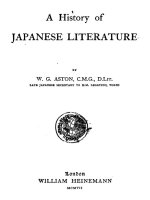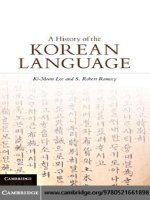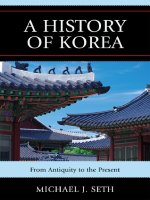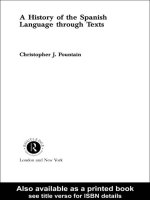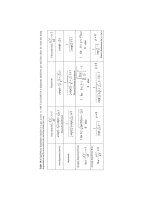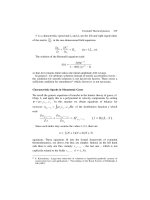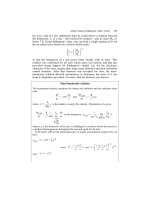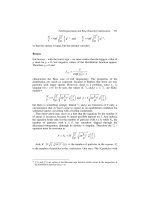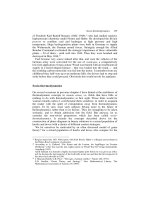Susan jacoby freethinkers a history of ame ism (v5 0)
Bạn đang xem bản rút gọn của tài liệu. Xem và tải ngay bản đầy đủ của tài liệu tại đây (1.78 MB, 305 trang )
F REETHINKERS
ALSO BY SUSAN JACOBY
Half-Jew
Wild Justice
The Possible She
Inside Soviet Schools
Moscow Conversations
FREETHINKERS
A HISTORY OF AMERICAN SECULARISM
SUSAN JACOBY
Metropolitan Books
Henry Holt and Company, LLC
Publishers since 1866
115 West 18th Street
New York, New York 10011
Metropolitan Books™ is a registered
trademark of Henry Holt and Company, LLC.
Copyright © 2004 by Susan Jacoby
All rights reserved.
Distributed in Canada by H. B. Fenn and Company Ltd.
Library of Congress Cataloging-in-Publication Data
Jacoby, Susan, date.
Freethinkers : a history of American secularism / Susan Jacoby.
p. cm.
Includes bibliographical references and index.
ISBN 0-8050-7442-2
1. Secularism—United States—History. 2. Freethinkers—United States—History.
I. Title.
BL2760.J33 2004
211’.4’0973—dc22
2003059294
Henry Holt books are available for special promotions and
premiums. For details contact: Director, Special Markets.
First Edition 2004
Designed by Fritz Metsch
The image of Thomas Paine is from an engraving in Samuel P. Putman, Four Hundred Years of Freethought (New York: Truth
Seeker Company, 1984), and is used, along with the picture of Robert Ingersoll’s oration, courtesy of the Center for Inquiry/Council for
Secular Humanism. The cartoon of “Mad Tom” and the images of Ernestine L. Rose, Lucretia Mott, and Elizabeth Cady Stanton appear
courtesy of the New York Public Library. The image of George E. Macdonald and the frontispiece, “The Story of the Truth Seeker,”
originally appeared in Volume I, Fifty Years of Freethought (1929), published by the Truth Seeker Company. The image of Clarence
Darrow originally appeared in Volume II, Fifty Years of Freethought (1931), published by the Truth Seeker Company. The photograph
of President George W. Bush in prayer was taken by Eric Draper and is used with permission of the White House.
Printed in the United States of America
10 9 8 7 6 5 4 3 2 1
FOR ROBERT AND IRMA BRODERICK JACOBY
The most formidable weapon against
errors of any kind is reason.
—THOMAS PAINE, 1794
Contents
Introduction
1 : Revolutionary Secularism
2 : The Age of Reason and Unreason
3 : Lost Connections: Anticlericalism, Abolitionism, and Feminism
4 : The Belief and Unbelief of Abraham Lincoln
5 : Evolution and Its Discontents
6 : The Great Agnostic and the Golden Age of Freethought
7 : Dawn of the Culture Wars
8 : Unholy Trinity: Atheists, Reds, Darwinists
9 : Onward, Christian Soldiers
10 : The Best Years of Our Lives
11 : Culture Wars Redux
12 : Reason Embattled
Appendix: Robert Ingersoll’s Eulogy for Walt Whitman, March 30, 1892
Notes
Selected Bibliography
Acknowledgments
Index
F REETHINKERS
INTRODUCTION
We have retired the gods from politics. We have found that man is the only source of political power,
and that the governed should govern.
—ROBERT GREEN INGERSOLL,
JULY 4, 1876
On the centennial anniversary of the signing of the Declaration of Independence, Robert Ingersoll, the
foremost champion of freethought and the most famous orator in late-nineteenth-century America, paid
tribute in his hometown of Peoria, Illinois, to “the first secular government that was ever founded in
this world.” Also known as “the Great Agnostic,” Ingersoll praised the framers of the Constitution for
deliberately omitting any mention of God from the nation’s founding document and instead
acknowledging “We the People” as the supreme governmental authority. This unprecedented
decision, Ingersoll declared, “did away forever with the theological idea of government.”1
The Great Agnostic spoke too soon. It is impossible to imagine such a forthright celebration of
America’s secularist heritage today, as the apostles of religious correctness attempt to infuse every
public issue, from the quality of education to capital punishment, with their theological values. During
the past two decades, cultural and religious conservatives have worked ceaselessly to delegitimize
American secularism and relegate its heroes to a kooks’ corner of American history. In the eighteenth
century, Enlightenment secularists of the revolutionary generation were stigmatized by the guardians
of religious orthodoxy as infidels and atheists. Today, the new pejorative “elitist” has replaced the
old “infidel” in the litany of slurs aimed at defenders of secularist values.*
Since the terrorist attacks of September 11, 2001, America’s secularist tradition has been further
denigrated by unremitting political propaganda equating patriotism with religious faith. Like most
other Americans, I responded to the terrorist assaults with an immediate surge of anger and grief so
powerful that it left no room for alienation. Walking around my wounded New York, as the smoke
from the ruins of the World Trade Center wafted the smell of death throughout the city, I drew
consolation from the knowledge that others were feeling what I was feeling—sorrow, pain, and rage,
coupled with the futile but irrepressible longing to turn back the clock to the hour before bodies
rained from a crystalline sky. That soothing sense of unity was severed for me just three days later,
when President George W. Bush presided over an ecumenical prayer service in Washington’s
National Cathedral. Delivering an address indistinguishable from a sermon, replacing the language of
civic virtue with the language of faith, the nation’s chief executive might as well have been the
Reverend Bush. Quoting a man who supposedly said at St. Patrick’s Cathedral, “I pray to God to give
us a sign that he’s still here,” the president went on to assure the public not only that God was still
here but that he was personally looking out for America. “God’s signs,” Bush declared, “are not
always the ones we look for. We learn in tragedy that his purposes are not always our own. . . .
Neither death nor life, nor angels nor principalities, nor powers, nor things present, nor things to
come, nor height, nor depth can separate us from God’s love. May he bless the souls of the departed,
may he comfort our own, and may he always guide our country.” This adaptation of the famous
passage from Paul’s Epistle to the Romans left out the evangelist’s identification of Jesus Christ as
God—an omission presumably made in deference to the Jewish and Muslim representatives sharing
the pulpit with the president.
Bush would surely have been criticized, and rightly so, had he failed to invite representatives of
non-Christian faiths to the ecumenical ceremony in memory of the victims of terrorism. But he felt
perfectly free to ignore Americans who adhere to no religious faith, whose outlook is predominantly
secular, and who interpret history and tragedy as the work of man rather than God. There was no
speaker who represented my views, no one to reject the notion of divine purpose at work in the
slaughter of thousands and to proclaim the truth that grief, patriotism, and outrage at injustice run just
as deep in the secular as in the religious portion of the American body politic.
Bush’s very presence in the pulpit attested powerfully to the erosion of America’s secularist
tradition; most of his predecessors would have regarded the choice of a religious sanctuary for a
major speech as a gross violation of the respect for separation of church and state constitutionally
required of the nation’s chief executive. Franklin D. Roosevelt did not try to assuage the shock of
Pearl Harbor by using an altar as the backdrop for his declaration of war, and Abraham Lincoln, who
never belonged to a church, delivered the Gettysburg Address not from a sanctuary but on the field
where so many soldiers had given “the last full measure of devotion.”
It is one of the greatest unresolved paradoxes of American history that religion has come to occupy
such an important place in the communal psyche and public life of a nation founded on the separation
of church and state. The tension between secularism and religion was present at America’s creation; a
secular government, independent of all religious sects, was seen by founders of diverse private
beliefs as the essential guarantor of liberty of conscience. The descendants of passionate religious
dissenters, who had fled the church-state establishments of the Old World in order to worship God in
a multiplicity of ways, were beholden to a godless constitution.2 From the beginning of the republic,
this irony-laden and profoundly creative relationship produced a mixture of gratitude and unease on
the part of its beneficiaries.
Given the intensity of both secularist and religious passions in the founding generation, it was
probably inevitable that the response of Americans to secularism and freethought—the lovely term
that first appeared in the late 1600s and flowered into a genuine social and philosophical movement
during the next two centuries—would be fraught with ambivalence. Beginning with the revolutionary
era, freethinkers periodically achieved substantial influence in American society, only to be vilified
in periods of reaction and consigned to the margins of America’s official version of its history.
American freethought derived much of its power from an inclusiveness that encompassed many
forms of rationalist belief. Often defined as a total absence of faith in God, freethought can better be
understood as a phenomenon running the gamut from the truly antireligious—those who regarded all
religion as a form of superstition and wished to reduce its influence in every aspect of society—to
those who adhered to a private, unconventional faith revering some form of God or Providence but at
odds with orthodox religious authority. American freethinkers have included deists, who, like many
of the founding fathers, believed in a “watchmaker God” who set the universe in motion but
subsequently took no active role in the affairs of men; agnostics; and unabashed atheists. What the
many types of freethinkers shared, regardless of their views on the existence or nonexistence of a
divinity, was a rationalist approach to fundamental questions of earthly existence—a conviction that
the affairs of human beings should be governed not by faith in the supernatural but by a reliance on
reason and evidence adduced from the natural world. It was this conviction, rooted in Enlightenment
philosophy, that carried the day when the former revolutionaries gathered in Philadelphia in 1787 to
write the Constitution.
Thomas Paine, the preeminent and much-admired literary propagandist of the Revolution, was
the first American freethinker to be labeled an atheist, denigrated both before and after his death, and
deprived of his proper place in American history. In 1776, Paine’s clarion call for steadfast
patriotism in dark times—“the summer soldier and the sunshine patriot will, in this crisis, shrink from
the service of their country; but he that stands it now, deserves the love and thanks of man and
woman”—had inspired his countrymen in every corner of the former colonies. But memories of Paine
the patriot would long be obscured by denunciations of his heretical views. In The Age of Reason
(1794), he put forth the astonishing idea that Christianity, like all other religions, was an invention of
man rather than God. Paine died a pauper and, nearly eight decades later, would still be subjected to
slurs by such eminent personages as Theodore Roosevelt, who dismissed him as a “filthy little atheist
. . . that apparently esteems a bladder of dirty water as the proper weapon with which to assail
Christianity.”3 Were it not for the unremitting efforts of Ingersoll, who, despite his nineteenth-century
fame and notoriety, is ignored in standard American history texts, Paine’s vital contributions to the
revolutionary cause might have suffered the same fate. Unfortunately, no champion arose in the
twentieth century to do for Ingersoll what Ingersoll did for Paine. In a country with less reverence
toward religious institutions, Ingersoll might occupy the historical position of a Voltaire, to whom he
was frequently compared by his contemporaries.
The only freethinkers who have received their due in American history are Thomas Jefferson
and James Madison, in spite of the fact that they were denigrated by their Calvinist contemporaries as
atheists, heretics, and infidels (then understood in its literal, original sense—unfaithful ones). It is
impossible to consign former presidents or the authors of the nation’s secular scriptures to a
historical limbo. Thus, Jefferson, Madison, and, to a lesser extent, George Washington, John Adams,
and Benjamin Franklin pose a vexing problem for twentieth-century political, religious, and social
conservatives intent on simultaneously enshrining the founding fathers and denying their intention to
establish a secular government.
The long struggle over the role of religion in American public and cultural life has been a slow,
uneven movement away from Americans’ original definition of themselves as a Protestant Christian
people, albeit leavened by a strong secularist bent that accommodated both non-Christians and the
nonreligious at a time when compulsory state religion was taken for granted throughout the world. At
the beginning of the twenty-first century, the American self-definition has been expanded to nonChristians in ways that were unimaginable only fifty years ago. Since the Second World War and the
Holocaust, public officials have increasingly substituted “Judeo-Christian” for “Christian” when
talking about the nation’s religious and ethical heritage. Religious Jews (as distinct from Jews as an
ethnic group), who make up just 1.3 percent of Americans, are now routinely invited to participate in
ecumenical ceremonies like the one held in the National Cathedral. Muslims, in spite of their recent
growth as a result of immigration and proselytizing among African Americans, are an even smaller
minority—one-half of 1 percent—yet they, too, are represented on most important civic occasions. In
areas of the country with large first- and second-generation communities of non-Christian immigrants,
Hindus and Buddhists are frequently asked to join Christians, Jews, and Muslims on public platforms.
The message is clear: we may be a multicultural people, but we’re all respectable as long as we
worship God in some way.
The one minority left outside the shelter of America’s ecumenical umbrella is the congregation
of the unchurched. Yet the secularist minority is much larger than any non-Christian religious group.
According to a nationwide opinion poll of Americans’ religious identification, conducted by the
Graduate Center of the City University of New York, the fastest-growing “religious” group in the
United States is composed of those who do not subscribe to any faith. From 1990 to 2001, the number
of the unchurched more than doubled, from 14.3 million to 29.4 million. Approximately 14 percent of
Americans, compared with only 8 percent in 1990, have no formal ties to religion. Sixteen percent,
and it is reasonable to assume that they make up essentially the same group as the unchurched,
describe their outlook on the world as entirely or predominantly secular. 4 It would be a mistake to
conclude that none of the “predominantly secular” believe in God; less than 1 percent described
themselves as atheists or agnostics, while the overwhelming majority simply said they had no
religion. However, in view of the opprobrium attached to the words atheist and agnostic in
American culture, I suspect that there are many more nonbelievers in this group than there are people
willing to call themselves nonbelievers. But a secularist’s specific metaphysical beliefs are
politically irrelevant, because insistence on the distinction between private faith and the conduct of
public affairs is precisely what distinguishes secularists from the religiously correct.
Even though more Americans may be viewing public issues through a secular lens, the influence
of religion at the highest levels of government has never been stronger or more public. This
contradiction has surfaced repeatedly in American history. Hard-core fundamentalist religion has
always flourished during periods of increasing secularization, and its adherents tend to be much more
singleminded than secularists: most secularists will vote for a religious believer who respects
separation of church and state, but few fundamentalists will vote for a secularist who denounces
religious influence on government. In 2004, it is impossible to imagine an avowed atheist or agnostic
winning or being nominated for the American presidency. In a nationwide opinion poll released in the
summer of 2003, fully half of Americans said that they would refuse to vote for an atheist for
president—regardless of his or her other qualifications.5 Lincoln, who refused to join a church even
though his political advisers—clearly not all-powerful “handlers” in the modern sense—argued that
formal religious affiliation would improve his chances of election, might well be unacceptable as a
major party presidential candidate today. Ronald Reagan, whose record of religious observance
during his Hollywood years was spotty at best, started turning up regularly at church services as soon
as he was elected governor of California and set his sights on the presidency. When Senator Joseph
Lieberman, a devout Orthodox Jew, was running for the vice presidency on the Democratic ticket in
2000, political pundits indulged in interminable self-congratulation about the growing tolerance of the
American people. While the positive response to Lieberman’s candidacy certainly attests to the
diminution of anti-Semitism, it was Lieberman’s open religiosity, not his ethnic Jewishness, that
enabled him to mix so effectively with evangelicals, High Church Episcopalians, and Roman Catholic
bishops. An avowedly secular, nonobservant Jew—one who considered himself Jewish in a cultural
rather than a religious sense—would never have been selected for a major party’s national ticket.
Although Democratic presidents have been much more careful to separate their private religious
views from public policy making, both Jimmy Carter, the first born-again Christian in the White
House, and Bill Clinton, the first president to publicly ask God’s forgiveness for adultery, contributed
to the blurring of the distinction between private faith and public responsibility.
In the Bush White House, the institutionalization of religion has reached an apotheosis. His
cabinet meetings routinely begin with a prayer, as the public learned from a startling front-page
photograph in the New York Times several years ago. The intertwining of religion and government
today goes far beyond the symbolic, although symbols are important in themselves. The battle over
abortion, now extended to stem cell research, is the longest-running dispute in which not only private
religious beliefs but the official teachings of various churches permeate public debate and influence
legislation. The Republican majority, joined by a fair number of Democrats, not only supports
government funding of religious charities but insists that churches should be able to use public money
to hire only members of their own faith. For the first time in American history, the judicial and the
executive branches of government have endorsed tax breaks for parents who wish to send their
children to religious schools. Biblical authority is cited by politicians and judges as a rationale for
the death penalty. Vital public health programs—the use of condoms to prevent the spread of AIDS,
family planning aid to Third World countries, sex education for American teenagers (unless it
preaches “abstinence only”)—are held hostage by the religious doctrines of a determined
conservative minority.
Yet the religiously correct continue to speak of a “naked public square,” a space in which
secular humanists supposedly have succeeded in muzzling the voices of faith.6 In The Culture of
Disbelief, Stephen L. Carter asserts that “the truth—an awkward one for the guardians of the public
square—is that tens of millions of Americans rely on their religious traditions for the moral
knowledge that tells them how to conduct their lives, including their political lives. They do not like
being told to shut up.”7 But no one is telling them to shut up—not that anyone could. And no one
denies that all public policy issues, whether they involve scientific research or the conduct of foreign
affairs, have both a moral and a pragmatic component. For individuals, morality is never a matter of
consensus: your countrymen may go to war, but you may not follow if your conscience forbids you to
do so. For a democratic society, however, there must be a moral consensus, extending beyond and in
some instances contradicting particular religious beliefs, to maintain the social contract. Both the
abolition of slavery and the civil rights movement a century later exemplify the kind of consensus that
transcends all religions and runs counter to some. It is often noted that religion played a major role in
both the nineteenth-century abolitionist and the twentieth-century civil rights movements, but, as
Lincoln pointedly observed, the Bible was used just as frequently to justify slavery as to support
emancipation. In the 1960s, America’s steps toward racial justice were ratified by a moral majority
—with a small m—that included both the men and women of faith and the nonreligious humanists who
had played a vital role in the civil rights movement. When President Lyndon Johnson proposed the
Voting Rights Act of 1965 and declared, in his memorable Texas twang, “We shall overcome,” he
was articulating a moral position that could and did command the respect of citizens of any or no
religion.
Not surprisingly, generations of social reformers, concerned about alienating religious
Americans who might otherwise support their causes, have attempted to minimize the importance of
the secularist influence in their ranks and protect themselves from guilt by association with the
ungodly. That strategy has consigned many nonreligious and social progressives to a historical
memory hole and is responsible for widespread ignorance of secularist contributions to the
abolitionist, feminist, labor, and civil rights movements. Elizabeth Cady Stanton, the eminent leader
of the nineteenth-century woman suffrage movement, was censured by her fellow suffragists and all
but written out of the movement’s official record after the 1895 publication of her Woman’s Bible ,
which excoriated organized Christianity for its role in justifying the subjugation of women. Only in
the 1980s, when a new generation of feminist scholars rediscovered Stanton, was her reputation
revived. Today, a similar impulse to downplay secularist leanings is at work among prochoice
groups. Abortion rights activists love to point to liberal ministers and rabbis, as well as to the
dissident lay group Catholics for a Free Choice, as evidence that being prochoice need not mean
being antireligious. And of course that is true, but it is a measure of the defensiveness of secularists
today that they are reluctant to forthrightly acknowledge the abortion rights movement as the product
of a secularist rather than a religious concept of personal liberty and social good.
This timidity—in sharp contrast to the boldness of proselytizing freethinkers of the nineteenth
century—has unquestionably played an important role in the demonization of American secularism.
Those who cherish secularist values have too often allowed conservatives to frame public policy
debates as conflicts between “value-free” secularists and religious representatives of supposedly
unchanging moral principles. But secularists are not value-free; their values are simply grounded in
earthly concerns rather than in anticipation of heavenly rewards or fear of infernal punishments. No
one in public life today upholds secularism and humanism in the uncompromising terms used by
Ingersoll more than 125 years ago. “Secularism teaches us to be good here and now,” Ingersoll
declared. “I know nothing better than goodness. Secularism teaches us to be just here and now. It is
impossible to be juster than just. . . . Secularism has no ‘castles in Spain.’ It has no glorified fog. It
depends upon realities, upon demonstrations; and its end and aim is to make this world better every
day—to do away with poverty and crime, and to cover the world with happy and contented homes.”8
These values belong at the center, not in the margins, of the public square. It is past time to
restore secularism, and its noble and essential contributions at every stage of the American
experiment, to its proper place in our nation’s historical memory and vision of the future.
*Throughout this book, I have taken the liberty of using the words secularism and secularist—even though the latter was not in common
usage until the second half of the nineteenth century—to denote a concept of public good based on human reason and human rights
rather than divine authority. The Oxford English Dictionary defines secularism as “the doctrine that morality should be based solely on
regard to the well-being of mankind in the present life, to the exclusion of all consideration drawn from belief in God or in a future state.”
The term first appeared in print in 1851 and soon took on a political as well as a philosophical meaning, distinguishing the secular (a much
older word than secularist) functions of government from the domain of religion. In eighteenth-century political discourse, the adjective
civil was the closest equivalent of secularist, and many of the founders used the word to refer to the public, nonreligious sphere of
government, as distinct from the private role of religion.
1
REVOLUTIONARY SECULARISM
The essential rationalism binding America’s founding secularists to one another was memorably
expressed by John Adams to Thomas Jefferson in an 1813 letter commenting on Britain’s repeal of an
old statute that made it a crime to deny the existence of the Holy Trinity. “We can never be so certain
of any Prophecy,” Adams wrote, “or the fulfillment of any Prophecy; or of any miracle, or the design
of any miracle as We are, from the revelation of nature i.e. natures God that two and two are equal to
four. Miracles or Prophecies might frighten Us out of our Witts; might scare us to death; might induce
Us to lie, to say that We believe that 2 and 2 make 5. But We should not believe it. We should know
the contrary.”1
In their seventies, with a friendship that had survived serious political conflicts, Adams and
Jefferson could look back with satisfaction on what they both considered their greatest achievement—
their role in establishing a secular government whose legislators would never be required, or
permitted, to rule on the legality of theological views. Trying to discern the true religious opinions of
the founders from their voluminous writings is rather like searching for the real Jesus in the
conflicting passages of the Scriptures. Jefferson’s political opponents in the early 1800s were just as
mistaken, and as hypocritical, to call him an atheist as his conservative modern rebaptizers are to
claim him as a committed Christian. Adams’s critics and admirers, then and now, have been equally
misguided in their attempts to portray him as a man of orthodox faith. What did distinguish the most
important revolutionary leaders was a particularly adaptable combination of political and religious
beliefs, constantly subject to revision in an era when modern views of nature, science, and man’s
place in the universe were beginning to take shape. These views included skepticism vis-à-vis the
more rigid and authoritarian religious sects of their day; the conviction, rooted in Enlightenment
philosophy, that if God exists, he created human rationality as the supreme instrument for
understanding and mastering the natural world; and the assignment of faith to the sphere of individual
conscience rather than public duty. The logical extension of such beliefs was a civil government
based not on the laws of God, as promulgated by self-appointed earthly spokesmen, but on the rights
of man.
In the half century before the Revolution, an extraordinarily dynamic culture, characterized by the
spread of both nonreligious freethought and religious dissent, provided fertile soil for the growth of
secularist ideas that would be translated into a civic ideal in the 1789 Constitution. The proliferation
of religious sects, and a hands-off policy toward religious pluralism on the part of many of His
Majesty’s governors, was a conspicuous feature of colonial society. Any pope or church-sanctioned
king would have been taken aback by the thanksgiving services held in August 1763 in New York
City to commemorate the British victory in the French and Indian War. There is of course nothing
unusual in the annals of human conflict about the victorious sides thanking God. What was unusual,
indeed unprecedented in a world of unquestioned union between church and state, was the religious
diversity in evidence on the day of thanksgiving proclaimed by His Majesty’s colonial governor. The
services were held in Episcopal, Dutch Reformed, Presbyterian, French Huguenot, Baptist, and
Moravian churches. Even more extraordinary was the participation of Congregation Shearith Israel,
representing the city’s small community of Sephardic Jews. The Jewish thanksgiving sermon was
based on Zechariah 2:10, “Sing and rejoice, O daughter of Zion: for lo, I come, and I will dwell in
the midst of thee, saith the Lord.”2 George III undoubtedly approved of the political sentiments
expressed by his colonial subjects on that day, but a king in possession of more wits might well have
sensed a revolution brewing in the peaceful coexistence in the New World of religious believers who
had only relatively recently ceased bloodying one another in the more enlightened parts of the Old
World. The public inclusion of multiple Christian sects, even if all were Protestant, manifested a
religious liberalism that not only set the colonies apart from their mother country but also underscored
the difference between Puritan New England and the already sinfully cosmopolitan city of New York.
The addition of Jews to the mix was far more radical, since Jews in the eighteenth century were
commonly listed by many orthodox Christians in a litany of detested unbelievers—“Jews, pagans,
infidels, heretics, deists. . . .” As defenders of monolithic state-established churches have always
known, the presence of many religions, unchecked by the inquisitor’s rack and pyre, tends to impeach
the claim of any religion to absolute truth and spiritual authority. Moreover, many contemporary
observers reported a widespread casualness toward formal religious observance by the beginning of
the revolution. In 1780, Samuel Mather, a member of the famous family that produced the firebreathing Puritan preachers Cotton and Increase Mather, complained that only one in six of his fellow
Bostonians could be counted on to attend regular church services. This does not mean that the
majority of Americans were unbelievers, but it does attest to the presence of powerful libertarian and
noncomformist impulses in the new nation.
The religious pluralism of colonial America, which militated against a common cultural
definition of religious heresy, also made room for freethought. As early as the 1750s, the spread of
deism—often used by its detractors as a synonym for freethought and atheism—was considered a
serious problem by orthodox clergymen. In 1759, the widely respected Reverend Ezra Stiles was
already convinced that “Deism has got such Head in this Age of Licentious Liberty, that it would be in
vain to stop it by hiding the Deistical Writings: and the only Way left to conquer & demolish it, is to
come forth into the open Field and dispute it on an even Footing.”3 Stiles was writing a letter to
express his disagreement with the president of Yale College, who had turned down a donation of a
library from a Newport merchant on the already anachronistic ground that Rhode Island, having been
founded by Roger Williams in response to Puritan persecutions in Massachusetts, was a schismatic
state. The devout minister’s acknowledgment of the futility of censorship was itself an indication of
the influence of American freethought.
Expanding literacy, especially in the northern colonies, contributed to the spread of freethought
beyond an educated elite to a larger audience of literate farmers, small businessmen, craftsmen, and,
in growing numbers, their wives and daughters. “In no part of the habitable globe is learning and true
useful knowledge so universally disseminated as in our native country,” declared Bostonian John
Gardiner in a Fourth of July oration on the eighth anniversary of the Declaration of Independence.
“Who hath seen a native adult that cannot write? who known a native of the age of puberty that cannot
read the bible?”4 Even allowing for patriotic hyperbole, the connection between America’s rising
literacy rate and the wider dissemination of sophisticated social, political, and religious, as well as
antireligious, ideas is obvious. Literate men and women did not need ministers to tell them how, and
what, to think about God. (In this respect, the Roman Catholic opposition to Bible reading in the
vernacular was much more protective of the church’s interests than was the Protestant emphasis on
reading the Scriptures in a language that could be understood.) Ordinary literate Americans might not
have been reading Locke, Hume, Newton, Voltaire, Rousseau, and Diderot, but they did read
secondhand accounts, in pamphlets and newspapers, of political and religious debates that drew on
all of the Enlightenment thinkers. If large numbers of Americans had not been familiar with both the
language and the philosophy of the Enlightenment, the secularist revolutionary leaders would not have
used those concepts in the nation’s founding documents. The Declaration of Independence and the
Constitution were written to be understood by literate Americans of every social background. Paine’s
polemical pamphlets on behalf of independence, as well as his later antireligious arguments, were
composed in the same straightforward language—a source of particular fury to clerics who could
only reply with abstruse theological arguments.
The expansion of literacy in the late colonial era was accompanied by a growing interest in and
respect for science—an important element of freethought in all countries affected by the
Enlightenment. The leaders of the American Enlightenment were well aware of how inferior the
American intellectual and scientific environment was to the elite established centers of learning in
Europe, and they hoped to remedy this disadvantage after the achievement of independence. But those
who knew Europe well were convinced that Europe’s intellectual superiority applied only to the most
privileged minority and that the majority of Americans were far better informed about science than
their European counterparts. From Paris in 1785, Jefferson wrote that “in science, the mass of
[European] people is two centuries behind ours.” Jefferson conceded, however, that Europe’s
“literati” were half a dozen years ahead of Americans, because it took that long for important new
books to cross the Atlantic and be thoroughly assimilated by American intellectuals. 5 Then as now,
American scientific interest focused not on theory but on the immense practical benefits to be derived
from discovering the secrets of the natural world—the subject of so many of Benjamin Franklin’s
popular scientific writings. But scientific curiosity was also rooted in the more general Enlightenment
passion for rationality. Respect for the laws of science—the Laws of Nature and of Nature’s God, as
the Declaration of Independence put it—translated into the conviction that both government and
religion should and could operate in a manner consistent with those laws.
By the time of the Revolution, it was impossible to dismiss the connection between emerging
concepts of political freedom and religious freethought, although the most religiously orthodox
patriots certainly wished to do just that. The fundamental ethos of the Revolution was opposed to
divine as well as earthly despotism. “Who would imagine,” the Revolutionary War hero Ethan Allen
asked in 1784, “that the Deity conducts his providence similar to the detestable despots of the world?
O horrible most horrible impeachment of Divine Goodness!”6 To Allen, better known today as the
leader of the Green Mountain Boys and an advocate of statehood for Vermont, rejection of the allpowerful Calvinist deity went together with rejection of the divine right of kings. The Reverend
Timothy Dwight, who, as president of Yale, would play a leading role in a concerted effort to
reestablish religious orthodoxy in the postrevolutionary nation, described Allen’s Reason the Only
Oracle of Man (1784) as “the first formal publication, in the United States, openly directed against
the Christian religion.”7 A disorganized and stylistically clumsy writer, Allen never achieved the
influence or notoriety that accompanied the dissemination of Paine’s The Age of Reason a decade
later. But his book, in spite of and also because of its rough-hewn style, offers considerable insight
into the revolutionary connection between political and religious freedom. Allen embodied the
anticlerical strain in early American freethought; although his antagonism toward ecclesiastical
hierarchies was directed chiefly at hellfire-and-damnation Calvinist ministers, his many derogatory
references to “priests” and “priest-craft” also reflected the strong influence of French Enlightenment
thought on the American revolutionary generation. 8 Notions of the depravity of human reason, Allen
argued, were cherished by priests because, if ordinary human beings were assumed to be perfectly
capable of reasoning for themselves, the clergy would be out of work. Allen also noted that “while
we are under the tyranny of Priests . . . it will ever be in their interest, to invalidate the law of nature
and reason, in order to establish systems incompatible therewith.”9
The link between political and religious freethought was not always so explicitly drawn, but it
was always in the air. It should not therefore be surprising that, even before the end of the
Revolutionary War, a radical new vision of absolute separation of church and state was set forward
by freethinkers as the logical outgrowth of political independence. In 1779, Jefferson proposed a bill
that would guarantee complete legal equality for citizens of all religions, and of no religion, in his
home state of Virginia. Jefferson’s was the first plan in any of the thirteen states to call for complete
separation of civil and religious authority, and seven years of fierce debate and political bargaining
would pass before a version of his bill was enacted into law. Virginia stood alone in marshaling a
legislative majority that, as Jefferson observed, “meant to comprehend, within the mantle of its
protection, the Jew and the Gentile, the Christian and Mahometan, the Hindoo, and infidel of every
denomination.”10 It is impossible to overstate the importance of Virginia’s 1786 Act for Establishing
Religious Freedom, for, much to the dismay of religious conservatives, it would become the template
for the secularist provisions of the federal Constitution.
When Jefferson first put forward a law to separate church and state, the Episcopal Church—the
American branch having declared its independence from the Church of England—represented the
official, or “established,” religion of the state of Virginia. The issue remained on the back burner until
the end of the war, when both freethinkers and dissenting evangelical Protestants renewed their
objections to the existence of a state church. The battle was joined in 1784 when Patrick Henry
introduced a bill in the Virginia General Assembly that would have assessed taxes on all citizens for
the support of “teachers of the Christian religion.” The proposal, which would have replaced the
single established Episcopal Church with “multiple establishments,” was eminently reasonable, even
tolerant, if you happened to believe that the state government should be in the business of supporting
Christian churches. James Madison was among those who did not, and he conveyed his views to the
Assembly in his “Memorial and Remonstrance against Religious Assessments.”
Madison’s eloquent “Memorial,” eventually signed by some two thousand Virginians, should be
as familiar to students of American history as the Declaration of Independence and the Constitution.
“Who does not see,” he asked in a passage that delineated his concern for personal freedom of
religion, “that the same authority which can establish Christianity, in exclusion of all other Religions,
may establish with the same ease any particular sect of Christians, in exclusion of all other Sects?
That the same authority which can force a citizen to contribute three pence only of his property for the
support of any one establishment, may force him to conform to any other establishment in all cases
whatsoever?” Madison’s advocacy of government freedom from religious control is equally explicit:
If Religion be not within cognizance of Civil Government, how can its legal establishment be
said to be necessary to Civil Government? What influence in fact have ecclesiastical
establishments had on Civil Society? In some instances they have been seen to erect a spiritual
tyranny on the ruins of Civil authority; in many instances they have seen the upholding of the
thrones of political tyranny; in no instance have they been seen the guardians of the liberty of the
people. Rulers who wish to subvert the public liberty, may have found an established clergy
convenient auxiliaries. A just government, instituted to secure and perpetuate it [liberty], needs
them not.
Citing the “malignant influence” of religious hatred not only on individuals but on “the health and
prosperity of the state,” Madison conceded that even a law guaranteeing complete religious liberty
might not be sufficient to extinguish ancient religious enmities. Nevertheless, he argued, a secular
government’s evenhandedness toward all forms of belief and nonbelief would serve “sufficiently” to
minimize the worst effects of religious discord on civil society and government.11
In the mid-1780s, Jefferson was in Paris, serving as America’s minister to France, so it fell to
Madison to lead the political battle against tax assessments for the support of Christian churches.
Henry’s assessment plan had powerful support from affluent Episcopal landowners, who, though they
had established an American church independent of the Church of England, were not at all averse to
emulating their mother Anglican church by filling their coffers from the public trough. As the debate
began, most dissenting Protestant sects, because they stood to benefit from the new tax levies, were
equally enthusiastic about Henry’s plan.
Then Madison’s “Memorial” was inserted into the mix. It was a masterful piece of publicity on
behalf of freedom of conscience, with an impact not unlike that of Thomas Paine’s celebrated
arguments, in “Common Sense,” on behalf of independence. And although Madison was speaking
from the perspective of an Enlightenment rationalist, his presentation of the pernicious possibilities
for state interference with religion appealed powerfully to nonconformist Protestants, including small
Quaker and Lutheran sects as well as the more numerous Baptists and Presbyterians, who had long
resented the domination of the Episcopalians. Although evangelicals did not share Madison’s and
Jefferson’s suspicions of religious influence on civil government—indeed, they wished to expand the
scope of their own influence—they eventually became convinced that dissenting denominations could
best flourish under a government that explicitly prohibited state interference with church affairs. And
they were willing to renounce government money to ensure government noninterference.
The best account of this often overlooked episode in American history appears in Thomas E.
Buckley’s Church and State in Revolutionary Virginia (1977). Buckley, a Jesuit priest, presents a
fairminded account of the secularist as well as the religious contributions to the passage of
Jefferson’s bill, underscoring the complementary and contradictory motives of both groups. For
Virginia’s minority religious groups, which included evangelical Baptists, Quakers, Presbyterians,
and Methodists, theological conviction went hand in hand with their desire to thwart any attempt by
the Episcopal Church to retain its privileged prerevolutionary position. Evangelical faith rested on a
personal, unmediated relationship between God and man, and any union between church and state
was seen not only as unnecessary but as an insult to the Creator, whose claims preceded those of any
civil government. The “Memorial” passages most significant to evangelicals declared that “in matters
of Religion, no man’s right is abridged by the institution of Civil Society, and that Religion is wholly
exempt from its cognizance. True it is, that no other rule exists, by which any question which may
divide a Society can be ultimately determined, but the will of the majority; but it is also true, that the
majority may trespass upon the rights of the minority.” 12 While secularists like Jefferson and Madison
were concerned mainly with limiting the influence of religious intolerance on civil government, the
evangelicals cared mainly about unfettered opportunity not only to worship in their own way but to
proselytize within society—a difference in motivation that would place the two groups on opposite
sides in many future political battles. At the time, though, the interests of the evangelicals and the
Enlightenment rationalists coincided and coalesced in a common support for separation of church and
state. During the Virginia debate, each side borrowed the other’s arguments and even appropriated
the other’s rhetorical devices.13
The language of natural rights was liberally employed by religious bodies opposing the
assessment bill. A petition from four hundred Quakers, wittily signed “your real Friends,” called the
proposed bill “an Infringement of Religious and Civil Liberty Established by the [Virginia] Bill of
Rights.” The petitioners noted tartly that it was not necessary for the government to make “Provisions
for learned Teachers,” since all knowledge of Christianity comes directly from Christ himself. 14 The
evangelical reverence for freedom of conscience also allowed for a sense of humor. One Baptist
petition was accompanied by a poem written by the Reverend David Thomas:
Tax all things; water, air, and light,
If there need be; yea, tax the night:
But let our brave heroick minds
Move freely as celestial winds.
Make vice and folly feel your rod,
But leave our consciences to God.15
Most secularist petitioners, well aware of the importance of religious support to their cause,
took care to include passages emphasizing their respect for religion. From Montgomery County in the
western part of the state—a hotbed of freethinkers—came a petition written by John Breckinridge, a
good friend of Madison’s, and signed by some three hundred landholders. Breckinridge argued, in
terms that were somewhat disingenuous, that religion would be secure only when “full Scope” was
given to “unbiased and unprejudiced Reason.”16 Only a small proportion of secularists were brave
enough to acknowledge that they were as interested in freedom of conscience for deists and
freethinkers as they were in freedom for conventional religious believers—though Jefferson’s
original 1779 bill extended equal rights to all. One petitioner from Amelia County, in a document
dated November 9, 1785, expressed his views in a fashion familiar to eighteenth-century readers—by
making fun of the ardent but usually futile efforts of preachers to convince unbelievers of the error of
their ways. Scoffing at the notion that government support of Christian teaching would foster
conversions, he asked, “Will the Deist come to hear preaching? How then are they to be Converted? .
. . The Deist many miles from church [is] laughing in his Sleeve or toping at a tavern. . . . How many
Deists have the Orthodox clergy Converted lately?”17
The two-year debate over the assessment bill produced petitions with more than 13,000
signatures in a state with fewer than 100,000 white men over twenty-one—the only segment of the
population with a voice in political matters. Petitioners opposing religious assessments outnumbered
supporters twelve to one.18 In the end, the secularists and dissident evangelicals easily carried the
day. Madison’s “Memorial,” and the attendant publicity in newspapers throughout the state, had
alerted every possible opponent of religious tax assessments. By the time Virginia lawmakers arrived
in Richmond for the beginning of the 1785–86 General Assembly, the assessment bill, which once
seemed certain of passage, had been relegated to the dustbin of history. Instead, Jefferson’s plan to
establish complete separation of church and state was taken up by the legislature. The bill did not
make it through the assembly without revisions that moderated the rhetorical force of its secular
arguments, but the result, unprecedented in both American and world history, achieved exactly what
Jefferson had intended—liberty for every kind of believer and unbeliever. The text of the law begins
with the words “Whereas, Almighty God hath created the mind free. . . .” Jefferson’s original bill had
placed a salute to reason before a bow to God: “Well aware that the opinions and belief of men
depend not on their own will, but follow involuntarily the evidence proposed to their minds; that
Almighty God hath created the mind free. . . .” However, the lawmakers overwhelmingly defeated a
move to acknowledge Jesus Christ rather than a nonsectarian deity. The rejection of any mention of
Jesus, Jefferson would recall thirty years later, proved that the law was meant to protect not only
Christians, and not only religious believers, but nonbelievers as well.19 The statement that “Almighty
God hath created the mind free” was a rhetorical flourish, not a legal requirement: the important point
for secularists was that no Virginian—in contrast to the prevailing practices in other states—would
have to affirm his belief in any god to run for public office or claim civic equality. Leaving out a
reference to the primacy of human reason was, though not a meaningless concession, far less
important than the unequivocal guarantee of freedom of thought at the heart of the statute:
Be it enacted by the General Assembly of Virginia that no man shall be compelled to frequent or
support any religious worship, place, or ministry whatsoever, nor shall be enforced, restrained,
molested, or burthened in his body or goods, nor shall otherwise suffer on account of his
religious opinions or belief; but that all men shall be free to profess, and by argument to
maintain, their opinion in matters of religion, and that the same shall in no wise diminish,
enlarge, or affect their civil capacities.
And though we will know that this Assembly, elected by the people for the ordinary purposes of
legislation only, have no power to restrain the acts of succeeding Assemblies, constituted with
powers equal to our own, and that therefore to declare this act irrevocable would be of no effect
in law; yet we are free to declare, and do declare, that the rights hereby asserted are of the
natural rights of mankind, and that if any act shall be hereafter passed to repeal the present, or to
narrow its operation, such act will be infringement of natural right.20
The significance of Virginia’s religious freedom act was recognized immediately in Europe.
News of the law was received with great enthusiasm—not by the governments of the Old World, with
their entrenched state-established religions, but by individuals who wished to promote liberty of
conscience in their own countries. The Virginia law, translated into French and Italian as soon as the
text made it across the Atlantic in 1786, was disseminated throughout most of the courts of Europe,
and, as Jefferson wrote Madison, “has been the best evidence of the falsehood of those reports which
stated us to be in anarchy.” Expressing his pride in Virginia’s leadership, Jefferson observed that “it
is comfortable to see the standard of reason at length erected, after so many ages, during which the
human mind has been held in vassalage by kings, priests, and nobles, and it is honorable for us, to
have produced the first legislature who had the courage to declare, that the reason of man may be
trusted with the formation of his own opinions.”21
In America, where the great debate over the federal Constitution was just beginning, Virginia’s law
was hailed by secularists as a model for the new national government and denounced by those who
favored the semi-theocratic systems still prevailing in most states. As the Constitutional Convention
opened in 1787, with George Washington as its president, legally entrenched privileges for Protestant
Christianity were the rule rather than the exception in most states. The convention could have
modeled the federal Constitution after the Massachusetts constitution of 1780, which extended equal
protection of the laws, and the right to hold office, only to Christians. And not all Christians:
Catholics were permitted to hold public office only if they took a special oath renouncing papal
authority “in any matter, civil, ecclesiastical or spiritual.” Even that restriction was not enough for the
most committed descendants of the Puritans; sixty-three Massachusetts towns registered official
objections to the use of “Christian” rather than “Protestant,” bearing out a prediction by Adams that
“a change in the solar system might be expected as soon as a change in the ecclesiastical system of
Massachusetts.”22 State religious restrictions were grounded not only in old prejudices but in the
relative political strength of various religious constituencies. The 1777 New York State constitution,
for example, extended political equality to Jews—who, though few in number, had considerable
economic influence in New York City—but not to Catholics (who were not allowed to hold public
office until 1806). Maryland, the home state of Charles Carroll, the only Catholic signer of the
Declaration of Independence, guaranteed full civil rights to Protestants and Catholics but not to Jews,
freethinkers, and deists. The possibility of equal rights for non-Christians had never even occurred to
Carroll. In his old age, he wrote, “When I signed the Declaration of Independence, I had in view not
only our independence of England, but the toleration of all sects professing the Christian religion, and
communicating to them all equal rights.”23 In Delaware, officeholders were required to take an oath
affirming belief in the Trinity, and in South Carolina, Protestantism was specifically recognized as the
state-established religion.
But the framers of the Constitution chose Virginia, not the other states, with their crazy quilts of
obeisance to a more restrictive religious past, as the model for the new nation. The Constitution is a
secularist document because of what it says and what it does not say. The first of the explicit
secularist provisions is article 6, section 3, which states that federal elective and appointed officials
“shall be bound by Oath or Affirmation, to support this Constitution; but no religious Test shall ever
be required as a Qualification to any Office or public Trust under the United States.” No religious
test. This provision, much less familiar to the public today than the First Amendment, was especially
meaningful and especially sweeping in view of the fact that the necessity of religious tests and
religious oaths for officeholders had been taken for granted by nearly all the governments of the
American states (not to mention those of the rest of the world) at the time the Constitution was
written. The addition of the word affirmation is significant, because it meant that the framers did not
intend to compel officeholders to take a religious oath on the Bible. The intent could not have been
clearer to those who wanted only religious men—specifically, Protestant believers—to hold office.
